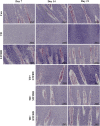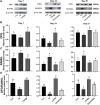Total Flavonoids of Rhizoma Drynariae Ameliorate Bone Growth in Experimentally Induced Tibial Dyschondroplasia in Chickens via Regulation of OPG/RANKL Axis
- PMID: 35694251
- PMCID: PMC9178197
- DOI: 10.3389/fphar.2022.881057
Total Flavonoids of Rhizoma Drynariae Ameliorate Bone Growth in Experimentally Induced Tibial Dyschondroplasia in Chickens via Regulation of OPG/RANKL Axis
Erratum in
-
Corrigendum: Total flavonoids of Rhizoma Drynariae ameliorate bone growth in experimentally induced tibial dyschondroplasia in chickens via regulation of OPG/RANKL axis.Front Pharmacol. 2022 Aug 11;13:969027. doi: 10.3389/fphar.2022.969027. eCollection 2022. Front Pharmacol. 2022. PMID: 36034847 Free PMC article.
Abstract
Background: Rhizoma Drynariae, traditional Chinese herb, is widely used to treat and prevent bone disorders. However, experimental evidence on the use of Rhizoma Drynariae extract, total flavonoids of Rhizoma Drynariae (TFRD) to treat tibial dyschondroplasia (TD) in chickens and its underlying mechanisms have not been investigated. Purpose: To evaluate the therapeutic effect of TFRD on leg disease caused by TD and elucidate its mechanisms in modulating the bone status. Methods: Thiram-induced chicken TD model has been established. The tibia status was evaluated by analyzing tibia-related parameters including tibial weight, tibial length and its growth plate width and by performing histopathological examination. The expression of tibial bone development-related genes and proteins was confirmed by western blotting and qRT-PCR. Results: The results showed that administration of TFRD mitigated lameness, increased body weight, recuperated growth plate width in broilers affected by TD and the increase of tibia weight and tibia length is significantly positively correlated with body weight. Compared with the TD group broilers, 500 mg/kg TFRD evidently reduced the damage width of the growth plate and improved its blood vessel distribution by elevating the gene expression levels of BMP-2 and Runx2 and OPG/RANKL ratio. Furthermore, correlation analysis found that the damage width of the growth plate was negatively correlated with the expression levels of BMP-2 and OPG. Conclusion: The present study revealed that TFRD could promote the bone growth via upregulating OPG/RANKL ratio, suggesting that TFRD might be a potential novel drug in the treatment of TD in chickens.
Keywords: Chinese herbal medicine; bone development; leg disease; tibial dyschondroplasia; total flavonoids of Rhizoma Drynariae.
Copyright © 2022 Xu, Zheng, Jin, Li, Lin, Shaukat, Zhang, Cao, Ashraf and Huang.
Conflict of interest statement
The authors declare that the research was conducted in the absence of any commercial or financial relationships that could be construed as a potential conflict of interest. The reviewer AL declared a shared affiliation with the author AS to the handling editor at the time of review.
Figures







References
-
- Chen G. Y., Chen J. Q., Liu X. Y., Xu Y., Luo J., Wang Y. F., et al. (2021). Total Flavonoids of Rhizoma Drynariae Restore the MMP/TIMP Balance in Models of Osteoarthritis by Inhibiting the Activation of the NF-Κb and PI3K/AKT Pathways. Evid. Based Complement. Altern. Med. 2021, 6634837. 10.1155/2021/6634837 - DOI - PMC - PubMed
LinkOut - more resources
Full Text Sources

